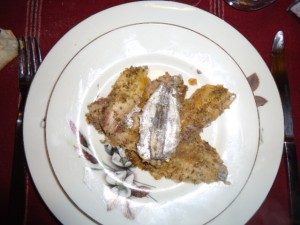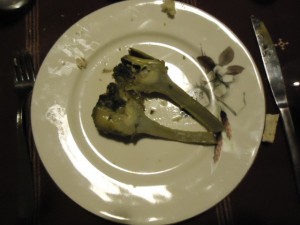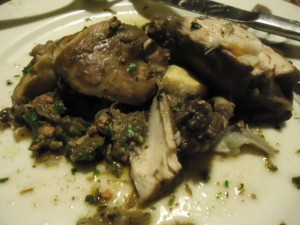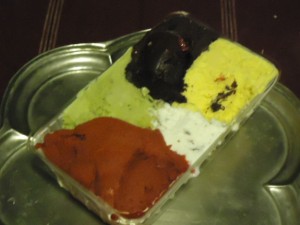Marco d’Eramo is a prominent Italian writer and journalist.
He writes for Il Manifesto, which is a left-wing journal, but Marco is a born contrarian and cannot abide predictable opinions of any sort. He has written several books but only one has been translated into English: it is called The Pig and the Skyscraper: Chicago and the History of our Future. It is a fascinating account of the city of today and what it tells us about the future.
Marco’s partner, Marina Forti, (who is seated beside him in this picture) also works for Il Manifesto and reports often on India and Pakistan. Very few European journalists are as knowledgeable as she is; even fewer have so wide a range of acquaintance in the Indian subcontinent.
I met Marco and Marina many years ago, and we have been good friends ever since. Marco and I have many things in common: we love good conversation and good food, and we both enjoy cooking. But Marco’s culinary philosophy is quite different from mine. Mine is a lazy, thrifty approach: maximal taste with minimal effort is my motto. Marco takes the opposite view: he produces meals of fantastic elaboration, spending hours shopping as well as cooking. This makes a meal at his home a kind of odyssey in which his guests follow him around Rome, going from market to market and stall to stall, learning about the lives of his favoured butchers, fishmongers and greengrocers. When I dine at Marco and Marina’s I don’t know which I enjoy more, the conversation or the food. The fact that their rooftop flat commands a view of the Colosseum adds a dimension of continuity with the past. To sit at their table is to know that the tradition of Roman feasting is alive and well.
This was the meal that Marco served when I was at their house earlier this month. At my request he sent me some of the recipes and I’ve included them although I would not myself attempt to follow them – I’ve found (as with real Indian food) that it requires enormous effort and expense to recreate Italian dishes outside their context. My culinary philosophy does not allow such indulgences – but when food is as good as this of course one wants to know what makes it so very delicious.
PUNTARELLE con acciughe (‘fresh chicory sprouts with anchovies, garlic, oil, vinegar, salt – You must leave it to rest for a couple of hours‘). ‘Puntarelle’ are a variety of chicory and are greatly loved in Rome.
ACCIUGHE GRATINATE (gratinated fillets of anchovies with breadcrumbs, parsley, oregano, oil&salt of course):
‘The anchovies: a good serve is of 6-8 anchovies for every person. You open them as an open wallet, taking out the fish bones and the head; you lay them in a baking-pan with the skin on the bottom and the open part on the top with abundant origan, then a thin layer of breadcrumbs, pepper and (not much) salt, and you put few drops of olive oil on each fish. You put it in a very hot oven for 3-4 minutes and you serve.’
INSALATA FRESCA DI MARE:
insalatine di varia specie, cetriolo (2) pomodori (2) avocadi (2) cipolla rossa (1) cozze (1 kg) vongole (1kg) gamberi (1kg), calamari (1,5 kg), coriandolo tritato, olio sale e il sugo di cottura dei calamari fatto evaporare (FRESH SEA SALAD: leaves of different green salads, 1 cucumber, 2 tomatoes, 2 avocados, 1 red onion, mussels, clams, shrimps, squids, coriander, oil&salt and the evaporated squids juice)
CARCIOFI ALLA ROMANA (Artichokes the Roman way):
Marco warns: ‘In the States it is impossible to make artichokes in the roman way, because the artichokes are not the same (in the US they are of the same variety as in France).’
CONIGLIO ALL’ASTIGIANA (braised rabbit marinated with several herbs, onion, oil & salt): ‘The recipe for the rabbit can be used with ducks, guinea-hen as well.
1 big onion cut very thin
Rosmarin (a small branch), bay leaves (4) sauge (6 leaves), thym, parsley, garlic, an abondant glass of red win, 3 pounds of meat in chunks.
You brown the onions; meanwhile you chop very finely rosmarin, bay leaves, sauge and thym;
when the onions are browned, you add the meat (but not the liver of the rabbit, duck or guinea-hen), you brown the meat on a very high fire; you add the herbs, the pepper (but not the salt) and the glass of wine and you cook about one hour with low fire (if it dries you add small water). After an hour you add the salt and finely chopped garlic, parseley and liver (all together), you cook just five minutes and you serve.’
The feast ended with the best gelati in Rome:
‘The name of the ice-maker is Fassi (from the name of the founder Giovanni Fassi). The name of the establishment is Palazzo del Freddo (Palace of Cold). The business is more tha a century old, since 1928 the location is at Via Principe Eugenio 65 and the web address is http://www.palazzodelfreddo.it/ there is an English version where you find the history, the products etc)
The accompaniments:
Champagne Veuve Cliquot;
Red Wines:
Vernatch (pronounced Fernach) from Alto Adige Sud Tirol
Inferno (Hell) from Valtellina (Norther Lombardia)









